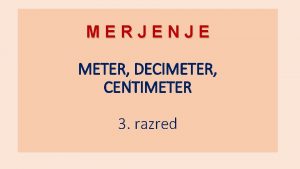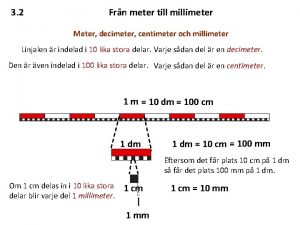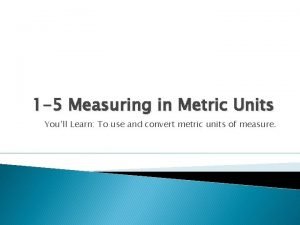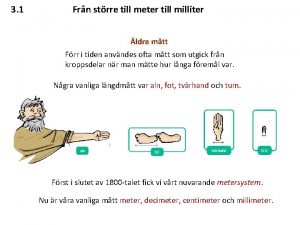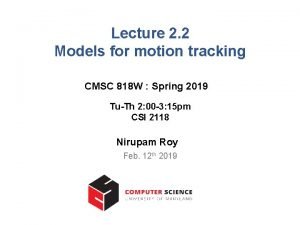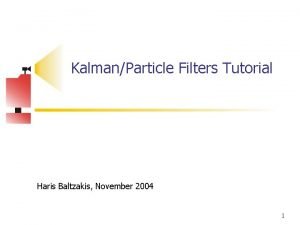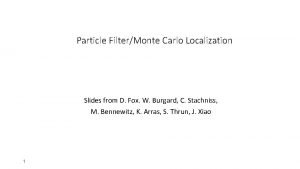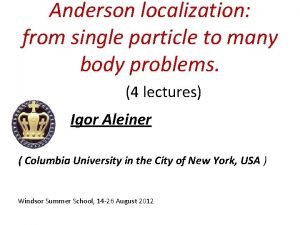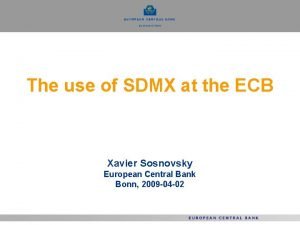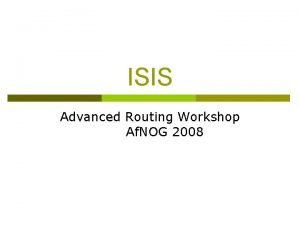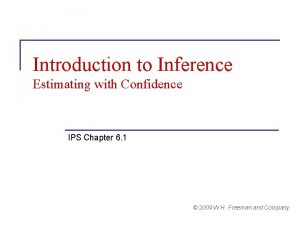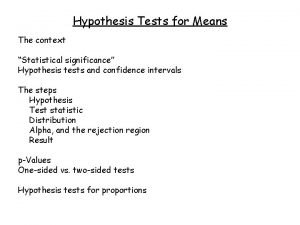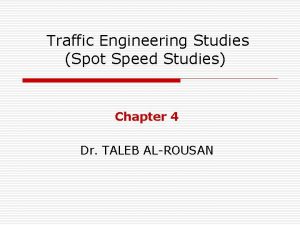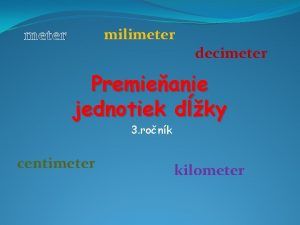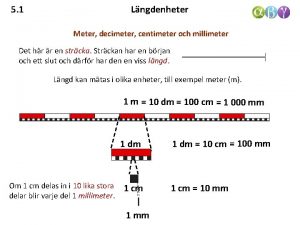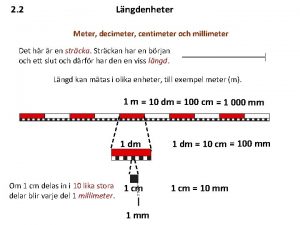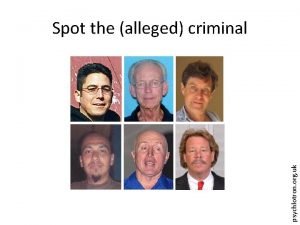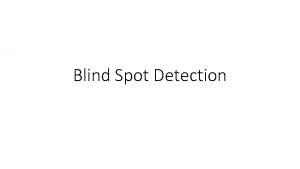Spot Fi Decimeter Level Localization using Wi Fi



























































- Slides: 59

Spot. Fi: Decimeter Level Localization using Wi. Fi Proposed by - Manikanta Kotaru, Kiran Joshi, Dinesh Bharadia, Sachin Katti Stanford University Presented by – Mohammad Nasim Imtiaz Khan and Abdullah Ash Saki

Applications of Indoor Localization Targeted Location Real Life Analytics Indoor Navigation Based Advertising (e. g. Airport Terminals) (Gym, Office, etc. . ) Indoor localization platform providing decimeter-level accuracy could enable a host of applications 2

Requirement for Ideal Localization System

1. Easily Deployable • Commercial Wi. Fi chips 3

1. Easily Deployable • Commercial Wi. Fi chips • No hardware or firmware change 4

1. Easily Deployable • Commercial Wi. Fi chips • No hardware or firmware change • No User Intervention 5

2. Universal • Localize any Wi. Fi device • No specialized sensors 6

3. Accurate • Error of few tens of centimeters 1 m 7

State-of-the-art System Deployable Universal Accurate RADAR, Bahl et al, ’ 00 HORUS, Youssef et al, ’ 05 Array. Track, Xiong et al, ’ 13 Pin. Point, Joshi et al, ’ 13 CUPID, Sen et al, ’ 13 LTEye, Kumar et al, ’ 14 Phaser, Gjengset et al, ’ 14 Ubicarse, Kumar et al, ’ 14 9

State-of-the-art System Deployable Universal Accurate RADAR, Bahl et al, ’ 00 HORUS, Youssef et al, ’ 05 Array. Track, Xiong et al, ’ 13 Pin. Point, Joshi et al, ’ 13 CUPID, Sen et al, ’ 13 LTEye, Kumar et al, ’ 14 Phaser, Gjengset et al, ’ 14 Ubicarse, Kumar et al, ’ 14 Spot. Fi, Kotaru et al, ’ 15 10

System Overview 11

Localization - Overview 12

Localization - Overview 13

Challenge - Multipath 14

Solving The Multipath Problem State-of-the-art Subcarriers Model signal on antennas alone Spot. Fi Model signal on both antennas and subcarriers Antennas 15

Step 1: Resolve Multipath 16

Signal Modeling Equal Distance Line 17

Phase 1 / frequency 0 Distance travelled by the Wi. Fi signal 18

Signal Modeling – Ao. A (Angle of Arrival) Equal Phase Line 19

Signal Modeling - Ao. A 3 2 1 20

Say There Are Two Paths… 21

Say There Are Two Paths… 22

Say There Are Two Paths… 23

Problem Statement CSI - Known 24

Problem Statement Parameters - Unknown 25

Problem Statement 26 Number of paths (or Ao. As) < Number of antennas (or equations)

Typical Indoor Multipath 27

That’s A Problem State-of-the-art Commodity Wi. Fi chips Number of antennas/equations should be at least 5 28

How To Obtain More Equations? Subcarriers Model signal on both antennas and subcarriers Antennas 29

Each Subcarrier Gives New Equations 30

Signal Modeling – To. F (Time of Flight) 31

Estimate both Ao. A and To. F More number of equations in terms of parameter of our interest 32

Say There Are Two Paths… 33

Say There Are Two Paths… 34

Problem Statement 35 Subcarrier 2 Subcarrier 1 CSI - Known

Problem Statement 36 Subcarrier 2 Subcarrier 1 Parameters - Unknown

37 Subcarrier 2 Number of equations = Number of Subcarriers x Number of Antennas Subcarrier 1 Problem Statement

Ao. A, To. F Estimates 38

Step 2: Identify Direct Path 39

Ao. A, To. F Estimates 40

Use Multiple Packets 41

Use Multiple Packets 42

Use Multiple Packets 43

Use Multiple Packets 44

Direct Path Likelihood • Smaller To. F Higher weight Lower weight Higher weight 45

Direct Path Likelihood • Smaller To. F Lower weight • Tighter Cluster Higher weight Lower weight 46

Direct Path Likelihood • Smaller To. F Lower weight • Tighter Cluster Higher weight • More Packets Higher weight Lower weight 47

Highest Direct Path Likelihood 48

Step 3: Localize The Target 49

Use Multiple APs Direct Path Ao. A = 45 degrees Signal Strength = 10 d. B Direct Path Ao. A = 10 degrees Signal Strength = 30 d. B 50 Direct Path Ao. A = -45 degrees Signal Strength = 20 d. B Find location that best explains the Ao. A and Signal Strength at all the APs

Use Different Weights Direct Path Ao. A = 45 degrees Signal Strength = 10 d. B Direct Path Likelihood Direct Path Ao. A = 10 degrees Signal Strength = 30 d. B Direct Path Likelihood 51 Direct Path Ao. A = -45 degrees Signal Strength = 20 d. B Direct Path Likelihood Use different weights for different APs

Evaluation 52

Testbed 40 m Target Access point 53 52 m AP Locations Target Locations

Indoor Office Deployment 10 m 40 m Ubicarse Spot. Fi 0. 3 m 0. 4 m Empirical CDF 16 m Array. Track 1 0, 8 0, 6 0. 4 m 0, 4 0, 2 0 0, 05 0, 5 5 Localization Error (m) 52 m Target Locations 54 AP Locations

Stress Test – Obstacles Blocking The Direct Path 40 m 52 m Target Locations 55 AP Locations

Stress Test – Obstacles Blocking The Direct Path 40 m Empirical CDF 1 0, 8 0, 6 1. 3 m 0, 4 0, 2 0 0, 049999958532 Localization Error (m) 52 m Target Locations 56 AP Locations

Effect of Wi. Fi AP Deployment Density Empirical CDF 1 0, 8 0, 6 3 APs 4 APs 5 APs 0, 4 0. 8 m 0, 2 0 0, 05 0, 5 5 Localization Error (m) 57

Conclusion • Deployable: Indoor Localization with commercial Wi. Fi chips • Accurate: Accuracy comparable to state-of-the-art localization systems which are not suitable for wide deployments • Universal: Simple localization targets with only a Wi. Fi chip 58

References • J. Xiong and K. Jamieson, “Arraytrack: A fine-grained indoor location system, ” NSDI ’ 13. • S. Kumar, S. Gil, D. Katabi, and D. Rus, “Accurate indoor localization with zero start-up cost, ” Mobi. Com ’ 14. • P. Bahl and V. N. Padmanabhan, “Radar: An in-building rf-based user location and tracking system, ” INFOCOM 2000. • S. Kumar, E. Hamed, D. Katabi, and L. Erran Li, “Lte radio analytics made easy and accessible, ” SIGCOMM ’ 14. • J. Gjengset, J. Xiong, G. Mc. Phillips, and K. Jamieson, “Phaser: Enabling phased array signal processing on commodity wifi access points, ” Mobi. Com ’ 14. • M. Youssef and A. Agrawala, “The horus wlan location determination system, ” Mobi. Sys ’ 05. • S. Sen, J. Lee, K. -H. Kim, and P. Congdon, “Avoiding multipath to revive inbuilding wifi localization, ” Mobi. Sys ’ 13. • K. Joshi, S. Hong, and S. Katti, “Pinpoint: localizing interfering radios, ” NSDI ’ 13. • M. Kotaru, K. Joshi, D. Bharadia, S. Katti, "Spot. Fi: Decimeter Level Localization Using Wi. Fi, " ACM SIGCOMM 2015. • All the icons are from the Noun Project https: //thenounproject. com/
 Voice localization using nearby wall reflections
Voice localization using nearby wall reflections Kubieke dm naar liter
Kubieke dm naar liter 1 meter je koliko decimetrov
1 meter je koliko decimetrov Decimeter centimeter
Decimeter centimeter Liter till dm
Liter till dm Decameter symbol
Decameter symbol Strre
Strre Cubic decimeter
Cubic decimeter English module grade 10
English module grade 10 Neural network ib psychology
Neural network ib psychology Localization of distributed data
Localization of distributed data Localization of distributed data in distributed database
Localization of distributed data in distributed database Markov localization
Markov localization Localization of behavior
Localization of behavior Buccal object rule
Buccal object rule Monte carlo localization for mobile robots
Monte carlo localization for mobile robots Icu localization
Icu localization Concept of probability
Concept of probability Markov localization
Markov localization Markov localization
Markov localization Localization in mobile computing
Localization in mobile computing Inclusive localization
Inclusive localization Markov localization
Markov localization Monte carlo localization python
Monte carlo localization python Localization and contextualization
Localization and contextualization Felix sasaki
Felix sasaki Contextualization and localization
Contextualization and localization Localisation industry standards association
Localisation industry standards association Anderson localization lecture notes
Anderson localization lecture notes Dnn roadmap
Dnn roadmap Dynamics nav localization
Dynamics nav localization Mobile robot localization
Mobile robot localization Erp localization
Erp localization Radiolabeling definition
Radiolabeling definition Touch receptor in skin
Touch receptor in skin Www.youtube.com
Www.youtube.com Action localization
Action localization Ecb sdmx
Ecb sdmx Localization courses
Localization courses Lqa quality assurance
Lqa quality assurance What is globalization testing
What is globalization testing System collections generic
System collections generic Defrost using internal heat is accomplished using
Defrost using internal heat is accomplished using Molecular level vs cellular level
Molecular level vs cellular level Isis level 1 vs level 2
Isis level 1 vs level 2 Significance level and confidence level
Significance level and confidence level Isis level 1 vs level 2
Isis level 1 vs level 2 What is the interpretation of a 96 confidence level
What is the interpretation of a 96 confidence level Confidence level and significance level
Confidence level and significance level Dfd level 0 and level 1
Dfd level 0 and level 1 Security level 0
Security level 0 3 level questions
3 level questions Thread-level parallelism
Thread-level parallelism Rcp hlsl
Rcp hlsl Sacss
Sacss How to spot a thesis statement
How to spot a thesis statement Welding joint design
Welding joint design Welding shop drawings
Welding shop drawings Visbreaking process flow diagram
Visbreaking process flow diagram What is spot speed
What is spot speed


